These eggs are hand-decorated by Jodi Smith, using the wax-resist technique used in central Europe since pre-Christian times.
The patterns are created by applying melted wax onto a genuine egg, then dipping the egg into dye. The wax prevents the dye from coloring the waxed area. Each color requires separate waxing and dyeing steps.
For the eggs in the Ukrainian style (“pysanky”), the wax is applied in fine lines using a tool (“kistka”) holding a small reservoir of wax melted over a candle flame.
For the eggs in the Lusatian style (also known as “Wendish” or “Sorbian”), small “stamps” are made by cutting the tips of feathers into geometric shapes. These feathers are dipped into melted wax, and then applied to the egg, forming triangles, squares, and diamonds of wax. The Lusatian designs also include dots and lines formed by dipping the head of a straight pin into the melted wax, and touching or pulling it along the egg. Lithuanian style (“marguaciai” *) uses exclusively the dots and lines made with the head of a pin.
At the end, all the wax is removed, the egg is hollowed, and then varnished to provide a durable finish.
Footnote: The “c” in “marguaciai” is supposed to have a “v” mark over it; that character is not reliably showing up properly. Does “?” appear correctly on your web browser? “margua?iai”
| Lusatian-Style Eggs for Sale 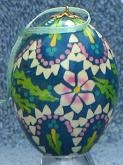 | Lusatian and Lithuanian Style Photo Gallery 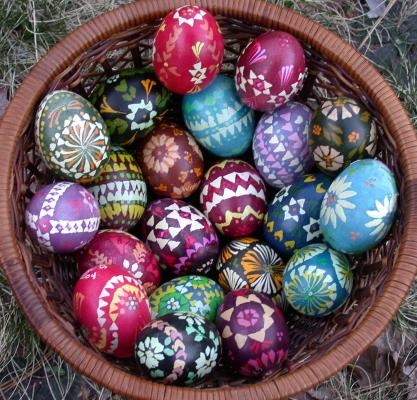 | Making Lusatian-Style Eggs 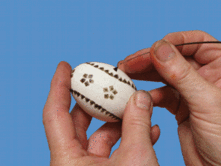 |
| Wax Pen (“Ukrainian-Style”) Eggs for Sale 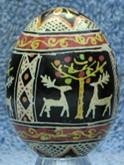 | Wax Pen (“Ukrainian-Style”) Photo Gallery 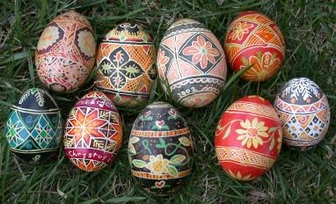 | Making Ukrainian-Style Eggs 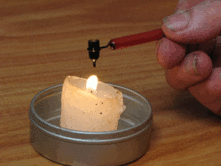 |
History
The egg is an ancient symbol of spring, new life, and rebirth. People have always been fascinated by the ability of a seemingly inert egg to suddenly hatch into a new life. In ancient Egypt, Greece, Rome, and China, people colored eggs and gave them as gifts at festive occasions.
In pre-Christian Slavic territories, colored eggs were one of the traditional gifts offered to the spirits of the tribal ancestors, and such eggs were placed on the graves of loved ones during the spring festivals. Many of the designs used on modern wax-resist eggs appear to have pre-Christian origins. Christianity officially arrived in Slavic central Europe in the 860’s, and in the Ukraine in 989. Decorated eggs gradually became associated with the Christian spring festival of Easter, and Christian interpretations were added to the earlier meanings of the symbols used on the eggs.
Each geographical region has its own style of egg decorating. Ukrainian pysanky eggs are especially famous. (Perhaps it is the influence of the former Soviet Union that has led people to think of these as “Russian” eggs.)
Lusatia is a region in southeastern Germany. It is Jodi Smith’s ancestral homeland. The native Lusatians are a Slavic ethnic minority, who call themselves “Sorbs.” The Germans call them “Wends”, and the name “Wendish” has made its way into the English language.
Decorated eggs were exchanged among family and friends, girls gave them to their sweethearts, and farmers placed them in the barns in hopes of bountiful harvests and to protect against lightning.
The name “pysanka” (plural is “pysanky”) comes from the Ukrainian word pysaty, which means “to write”.
Many traditional artists consider that the patterns and colors used to decorate eggs have symbolic meaning. People do not agree about what the specific meanings are.
Before modern synthetic dyes, eggs were colored with plant dyes, similar to the dyes used on cloth at the time. Onion skins give gold, orange, and brown colors. Brazilwood gave the highest quality red. Red cabbage gives blue. Oak, sumac, or bramble leaves give black. These plant dyes are more difficult to work with than modern dyes, and making a four-colored egg was considered a mark of great skill.